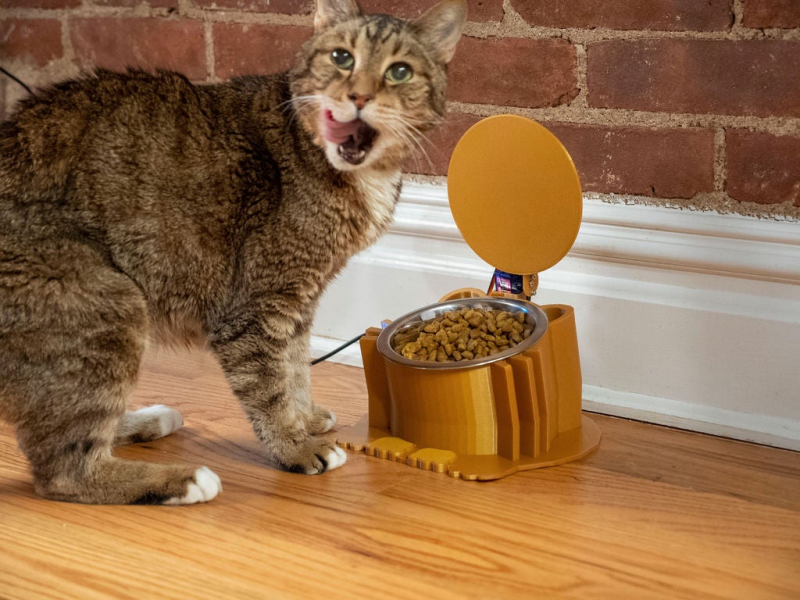Most of these stories start with a cat standing on someone’s chest, begging for food at some obscene hour of the morning. But not this one. Chaz the cat is diabetic, and he needs to get his insulin with breakfast. The problem is that Chaz likes to eat overnight, which ruins his breakfast appetite and his chances at properly metabolizing the insulin. [Becky] tried putting the bowl away before bed, but let’s face it — it’s more fun to solve a problem once than to solve the same problem every night.
[Becky]’s solution was to design and print a bowl holder with a lid, and to cover the bowl when the cat diner is closed using a small servo and a NodeMCU. It looks good, and it gets the job done with few components. Chaz gets his insulin, [Becky] gets peace of mind, and everybody’s happy. This isn’t going to work for all cats, because security is pretty lax. But Chaz is a senior kitty and therefore disinterested in pawing at the lid to see what happens. Claw your way past the break to see [Becky]’s build/demo video featuring plenty of cat tax coverage.
We’ve seen a lot of cat feeding apparatus around here, but few that solve a specific problem like this one. If it’s overengineering and cat metrics you want, come and get it.















My cat would destroy that contraption in less than one minute.
Which, of course, doesn’t mean that said contraption isn’t a thumbsup-worthy build!
Current cat, would upend it and bang it around until food fell out.
Former cat #1 would spend days tunnelling through the side of the housing.
Former cat #2 you would not see anything wrong, the food would just be missing… after 6 months investigating and wiring the whole house with high def IR security cams, you’d eventually see him in the shadows of a nearby corner, paw tapping on an Archer Space patrol walkie talkie morse key to fuzz the electronics with RF at close range and make it open, where he’d run over, wedge it open with a pen, eat his fill then close it, put everything back where he found it and do an academy award performance of innocence when confronted with the evidence. I miss the sneaky bugger though.
Nice bowl! If the cat destroys the lid, it’ll be fun to try other ones like clamshells and sliding lids to see what works best.
Excellent build! The only thing I would need to add is a lot of armor plating.
https://blondihacks.com/furiosas-cat-feeder/
All felines are different… and Sprocket’s tenacity immediately came to mind when I saw the design of the feeder above (having read the article some time ago).
What you designed is likely far more robust, but an in-between model could swap the PLA for a round tube of appropriate diameter for the bowl to sit in, and an over-sized metal lid which clamps down on the bowl, and would be pivoted by a sturdy worm-gear arrangement.
First I bought an automatic litter box cleaner, then I bought an automatic feeder and now my cat is evicting me! Nice feeder though.
Minor correction: if he doesn’t eat a decent breakfast, she can’t *administer* his post-breakfast insulin, which throws off his insulin schedule.
(Insulin is injected, not eaten.)
I’ve an inherited outside cat (I’m allergic and my wife’s mom is no longer able to take care of the cat), and our property backs up to wild space so I have to put the cat food bowl in the BBQ ever night to keep the raccoons away. I’ve looked at these auto cat feeders with interest, but none of the designs I’ve come across look like they’d survive a determined raccoon…
Automated nerf gun turret with machine learning to differentiate a cat from a raccoon :-P
That might work, but I think a water cannon turret is likely far more effective than the nerf gun. One advantage of the water cannon is that it has a much larger magazine than any practical nerf gun. Another advantage is that you don’t need to manually fetch the spent rounds for reloading/recycling.
And cats also tend to eat those darts. That’s the reason why my 3d printed nerf gun turret stays in the box, after one cat vomitted a dart. -. –
I like to joke that I am a full-stack Veterinarian, being able to code backend, frontend, embedded and AI.
Anyway, I think your approach starts with the wrong problem in mind. It’s not a good thing to give cats access to food continuously. Even for non-diabetics. There is a very good series on animal planet (and sometimes youtube) called “My Cat From Hell”, which taught me basically everything I know about cat behavior, and the host vigorously recommends distinct feeding.
And with diabetics, it’s even more important to have fasting periods before meals. It really helps with predictability. At least in Humans, it has been shown that long periods of fasting reduce insulin-tolerance, and it actually worked for my own diabetic issues. Though if I remember correctly, cats mostly have Type I or a Type II that has “converted” to Type I because the high glucose levels are toxic to the cells producing the insulin. And cats try to hide such conditions so they are rarely diagnosed until it’s already very bad!.
Clinicians have made good experiences with continuous glucose monitoring using sensors. It really beats pulling blood multiple times a day from a cat that has gone through the procedure a hundred times already and knows how to make it the absolute worst experience possible for you.
But those sensors require a cone, so they’re not really practical for use at home.
I like how the bowl is slightly raised, this can help senior cats with arthritic spines.